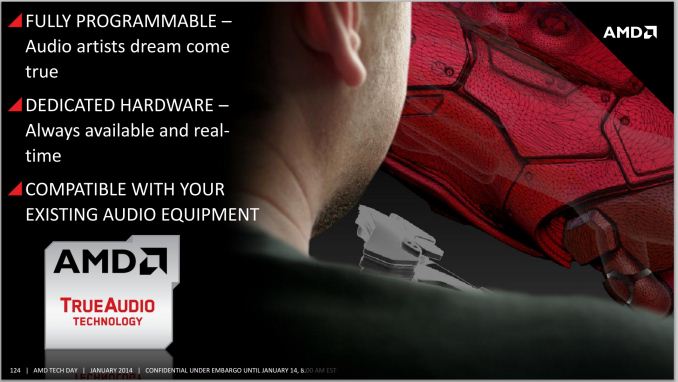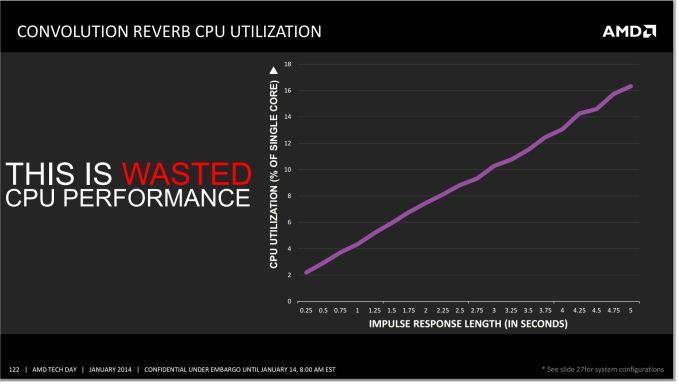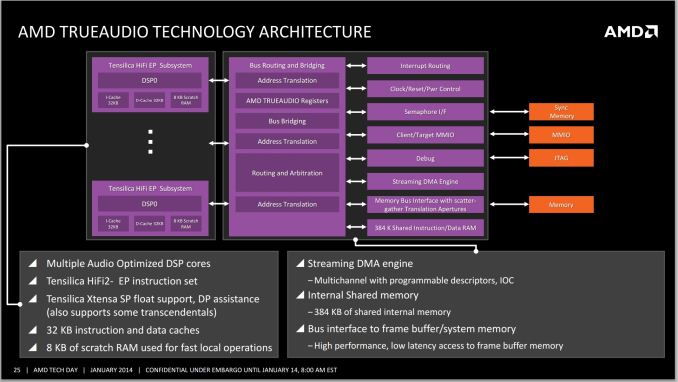AMD Kaveri Review: A8-7600 and A10-7850K Tested
by Ian Cutress & Rahul Garg on January 14, 2014 8:00 AM ESTTrueAudio
As part of the Kaveri package, AMD is also focusing on adding and updating their fixed function units / accelerators. Due to the jump on the GPU side to GCN we now have the TrueAudio DSP to allow developers to increase the audio capabilities in game, and both the Video Codec Engine (VCE) and Unified Video Decoder (UVD) have been updated.
All the major GPU manufacturers on the desktop side (AMD, NVIDIA, Intel) are pushing new technologies to help improve the experience of owning one of their products. There are clearly many ways to approach this – gaming, compute, content consumption, low power, high performance and so on. This is why we have seen feature like FreeSync, G-Sync, QuickSync, OpenCL adoption and the like become part of the fold in terms of these graphics solutions.
AMD’s new feature is TrueAudio - a fully programmable dedicated hardware element to offload audio tasks to.
The main problem with developing new tools comes down to whether they should be implemented in a general fashion or with a dedicated element. This comes down to the distinction of having a CPU or an ASIC do the work – if the type of work is specific and never changes, then an ASIC makes sense due to its small size, low power overhead and high throughput. A CPU wins out when the work is not clearly defined and it might change, so it opens up the realm of flexibility in exchange for performance per watt.
CPUs are now significantly powerful that a range of audio based techniques are available to them and the algorithms are optimized. The only limitation in this regard is the imagination of the developer or audio artist, which actually becomes part of the problem. When implementing an audio filter on the fly to a video game, the processing via the CPU can be overly taxing, especially when the effect is persistent over a long time. The example AMD gave in their press slide deck is one of adding reverb to an audio sample. The longer the reverb, the bigger the draw on CPU resources:
AMD cites this CPU usage as the effect of one filter on one audio sample. Imagine being in a firefight situation in a video game, whereby there are many people running around with multiple gunshots, splatter audio and explosions occurring. Implementing effects on all, and then transposing audio location to the position of the character is actually computationally expensive, all for the sake of realism. This is where the TrueAudio unit comes into play – the purpose is to offload all of this onto a dedicated bit of silicon that has the pathways built in for quicker calculations.
TrueAudio is also implemented on AMD's latest-generation R9 260 and R9 290 video cards – basically anything at least GCN 1.1 and up. Meanwhile we also know that the PS4’s audio DSP is based on TrueAudio, though given the insular nature of console development it's not clear whether the APIs are also the same on both platforms. AMD for their part is working with major audio middleware plugins (wwise, Bink) in order to help develop the TrueAudio ecosystem, so even in the case where the APIs are dissimilar, middleware developers can abstract that and focus on the similarities in the hardware underneath.
As is usually the case for these additional hardware features, games will need to specifically be coded to use TrueAudio, and as such the benefits of TrueAudio will be game specific. At the same time there are not any games currently on the market that can take advantage of the feature, so the hardware is arriving before there is software ready to use it. The first three games on AMD's list that will support TrueAudio are Murdered: Soul Suspect, Thief, and Lichdom. Much like FreeSync, I expect the proof is in the pudding and we will have to wait to see how it can affect the immersion factor of these titles.
Unified Video Decoder and Video Codec Engine
I wanted to include some talk about the UVD and VCE with Kaveri as both are updated – we get UVD 4, an update to error resiliency for H.264, and VCE 2, as shown below:
Of the two blocks, the improved VCE has the more interesting improvements to discuss. With the addition of support for B frames in H.264 encoding, the resulting ability to do backwards frame prediction should help improve the resulting image quality from VCE and/or reduce the required bitrates for any given quality level. Meanwhile the addition of support for the higher quality YUV444 color space in the H.264 encoder should help with the compression of primarily linear lineart/text, which in turn is important for the clarity of wireless displays.





















380 Comments
View All Comments
extremesheep49 - Friday, February 21, 2014 - link
I don't know if anyone will even see this now but..."The reality is quite clear by now: AMD isn't going to solve its CPU performance issues with anything from the Bulldozer family. What we need is a replacement architecture, one that I suspect we'll get after Excavator concludes the line in 2015."
I don't know that this conclusion is very fair considering this statement if you compare it to a previous article linked below. The linked article recommends a (currently) $100 100W A8-5600K. The Kaveri equivalent is a $120 45W CPU of approximately the same performance.
Doesn't the linked article's recommendations contradict your Kaveri conclusion at least for some cases? Kaveri's CPU performance probably is sufficient for many discrete GPU setups.
http://anandtech.com/show/6934/choosing-a-gaming-c...
Quote from link:
"Recommendations for the Games Tested at 1440p/Max Settings
A CPU for Single GPU Gaming: A8-5600K + Core Parking updates"
Novaguy - Sunday, February 23, 2014 - link
Gaming performance is usually (but not always) GPU bottlenecked, not CPU bottlenecked.The reason why a trinity was getting recommended in a lot of gaming boxes was that in dollar limited scenarios, you'll often get better gaming performance mating a $120 quad core trinity with a $300 gpu, versus a $220 i5 with a $200 gpu.
For even better results, mate an $80 Athlon II X4 750K if you're going discrete gpu, but I don't think the gpu-less trinity chip was available then.
PG - Monday, February 24, 2014 - link
I wanted to compare Kaveri to some other cpus not in this review. Bench would be perfect for that, but the Kaveri cpus are not listed there. Why? Can they be be added?Cptn_Slo - Tuesday, April 1, 2014 - link
Well at least this shows that AMD is able to increase performance significantly given the appropriate die shrink. I'm a big Intel fan but a healthy company/market needs competition, and looks like AMD is able to offer that in at least some areas.zobisch - Wednesday, April 2, 2014 - link
I have an h60 cooler on my 7850k with 2400mhz ram OC'd to 4.4ghz and I love it... I think the corner for APU's will really turn when DDR4 boards come out. I also would like to see an 8core, 24 compute gpu as well but that's probably a die shrink or more away.vickfan104 - Tuesday, May 6, 2014 - link
An Xbox One/PS4-like APU is what I'm still looking for from AMD. To me, that seems like the point where an APU becomes truly compelling as opposed to CPU + discreet GPU.P39Airacobra - Thursday, January 1, 2015 - link
I still can't understand why anyone would be insane enough to pay the outrages high price for a AMD APU simply because it has a built in GPU that can play some games! When for the same price you can get a high end i5 CPU and mid range GPU for a few dollars more! Or for the exact same price you can get a AMD quad and a mid range GPU. Either choice would bloaw any AMD APU out of the water! Yes you can crossfire the APU, But you can also crossfire and SLI regular GPU's. Besides by the time you paid the money for a AMD APU and a GPU to crossfire with it you could have got a nice i3 or FX 6300 or even a last gen IVY i5 with a GPU like a R9 270 or a GTX 660. And either one of those would blow away a APU/Crossfire setup! What are you people thinking? I swear people today would not only buy the Brooklyn bridge once but more than once!P39Airacobra - Thursday, January 1, 2015 - link
Most logical thing to do is buy FX-6300 for $119 and a Motherboard for $60 and then buy a GTX 660 or a R9 270 and buy a 1600x900 resolution monitor and then you will be able to max out anything.P39Airacobra - Thursday, January 1, 2015 - link
Besides 60fps on Medium/High at only 1280x1024 is a laugh! A GT 740 and a R7 250 can do better than that!kzac - Monday, February 16, 2015 - link
After living with the processor on a gigabyte main board for the past several months, I can honestly say its bested both the core i3 and i5 systems (some quad core) I have used in the past. What it might not score on benchmarks for all out throughput it makes up for in its multitasking capability. What normally crashes my i3 and makes my i5 struggle while multitasking (many things open and operating at the same time), doesn’t tend to effect the A10 APU. The core i3 i am using is the later 3220 chip which completely chokes with anything above average multitasking under W7pro, even though it has 12 gig of 1600 ram. The core i5 was better at multitasking than the core i3 but still not near as effective at multitasking as the AMD A10 7850. Where I cannot speak to the performance of the AMD A10 for gaming, for multitasking is very effective.For gaming I have used the FX series AMD processors, both Quad Core and 8 core.